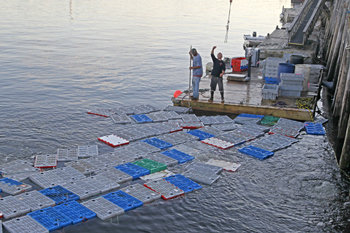BAIT FUTURES continued from Home Page

Loading lobster crates at JJ Lobster, Rockland, Maine. A healthy lobster resource, very low lobster prices, rising bait prices, expensive fuel and questions about the introduction of new bait species are all a part of the challenge to find profitability for lobstermen. ©Photo by Sam Murfitt
The report said that, although the Maine lobster fishery is heavily dependent on the herring fishery to supply fresh, salted and frozen bait, recent changes in the status and management of the herring fishery “have created significant concern over the future availability of bait for the lobster fishery.”
Expectations that herring could become too scarce, or too expensive, “have caused increasing interest in alternative baits as supplements or replacements,” the report said.
The demand for alternative lobster baits is rising, the report said. One bait replacement has been fish processing by-products, the report said.
“Two examples of by-products would be the use of carp and salmon heads/racks (complete fleshed head attached to bone skeleton),” the report said.
However, said the report, there may be a risk both of introducing “exotic diseases” to Maine’s marine organisms and of lobster become a vector that allows disease to be further distributed.
The report documented the authors’ study of an infectious viral pathogen called viral hemorrhagic septicemia (VHS), “a major bio-security threat to both freshwater and marine aquatic environments in the U.S.”
VHS and related virus strains have been found in European aquaculture operations and in a variety of marine fishes in the North Pacific, North Atlantic, the seas around northern Europe and Japan, and in the Great Lakes, the report said.
The disease’s unintentional introduction to the Great Lakes caused “significant mortalities in many fish species and it has been estimated that it will take this ecosystem several decades to recover its bio-diversity and for the wild fisheries biomass to return to their pre-2004 levels,” the report said.
The report continued, “it is important to acknowledge that there exists a risk that fish by-products imported from the Great Lakes watershed into Maine as lobster bait would pose a risk of introducing this serious pathogen to Maine. The introduction of this serious pathogen would jeopardize our state’s [Maine’s] disease free status, limit the export of live and dead sea food from the state and have a serious economic impact on our seafood industry.”
The report concluded that the VHS virus “could survive in bait beyond the usable shelf life of the bait through refrigeration and freezing….From this work, it can be concluded that the risk of introducing exotic viral agents to the marine environment by using infected bait products is high.”
The report said that, while it is possible for native bait stocks to harbor pathogens, “fish baits harvested locally and sold locally from the Gulf of Maine for the lobster industry or other fishing industries have the lowest potential of moving pathogens to a new area as they originate from the surrounding watershed.”
A possible caveat to that conclusion, the report said, might be the use of salmon racks that are byproducts of the salmon aquaculture industry in Maine. A viral pathogen called infectious salmon anemia (ISA) has been found in some Maine salmon pens, but the disease is closely monitored by the industry.
“Baitfishes originating from non-GOM sources pose the highest risk of new pathogen introduction,” the report said. “This risk reaches beyond the lobster industry and crosses into natural marine fisheries and aquaculture industries. Particular consideration must be placed on documented emerging and exotic pathogens such as VHSV.”
The report presented a list of considerations for the monitoring and control of exotic pathogens. These included the use of bait sources only from the Gulf of Maine, pasteurization or gamma radiation treatments of fish bait products, documentation of geographical zones outside the gulf that have documented freedom from pathogens of concern in Maine, inspection of fish product to be used as bait, selection of baits from states with thorough fish health surveillance programs, require bait dealers or suppliers to establish a type of federally regulated food safety system called the Hazard Analysis and Critical Control Points program to document bait origin and handling, select alternative freshwater species that have no known pathogens known to spread to the marine environment.
“There are all different kinds of baits coming in from Vietnam, Australia, the West Coast,” Carter said at the Zone B Council’s meeting.
Carter, who is also a member of the LAC, said the LAC agreed that maintaining chain-of-custody records for bait products will be an important step.
“It’s huge. It really turned into something huge,” he said.
